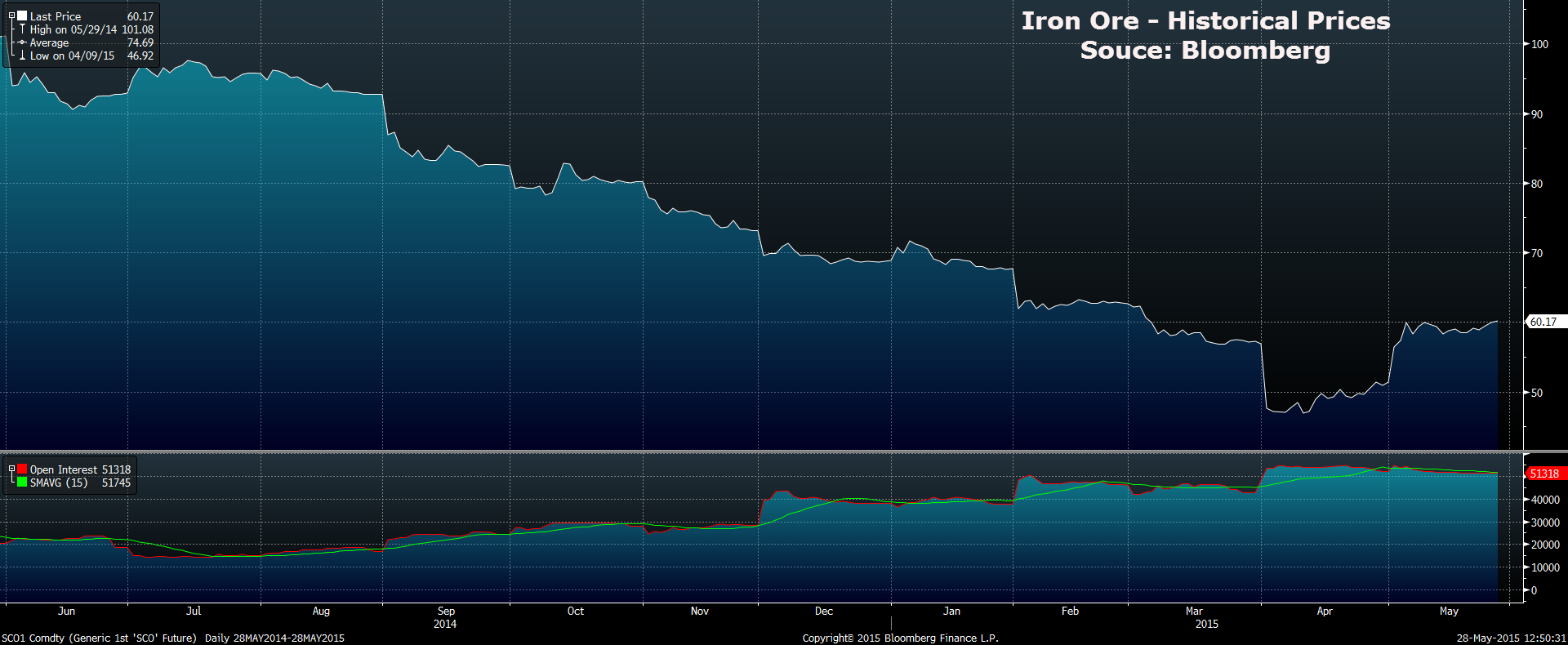The price of iron ore has continued to be driven lower, mainly through the low cost expansion projects within Australia and Brazil. Prices for the commodity have continued falling from last July’s, high of $94.75/t, to trade currently around the $60.00/t level. This significant fall has placed many of the smaller producers under pressure as well as the Australian government’s tax receipts. Subsequently, the viability of many of the smaller producers is at risk and this has led to a range of voices calling for a change in production strategy.
There is a view, perpetuated by the smaller mining concerns, that a cartel could be created to stabilise prices at a point where all market participants can benefit. Currently, two thirds of the world’s iron ore supply is controlled by three major producers. Accordingly, this alternate view would have the major players fix global iron ore prices at a point which would maximise profits for all within the industry.
In principle, further low cost expansions could be restricted, and prices allowed to stabilise at a higher point. This would potentially allow smaller operators to set prices on a steep curve at a point that would provide economic profits whilst the risk of increased competition or supply.
However, cutting production would likely fly in the face of the continual march towards efficiency within the mining plays. In fact, Goldman Sachs estimates mining efficiency is increasing within Australia, at a rate close to 4.0%/year. These gains in efficiency lead to significantly higher production whilst reducing operating costs and represent a shifting of the efficiency frontier.
Also, coordinating such an agreement amongst the three major participants would be extremely problematic. Historically, such agreements, evident within the oil industry, have been undertaken when there are one or two major competitors within the segment. Adding an additional party to any cartel agreement is likely to significantly complicate any predictive assessment of the competitive outcomes.
However, the elephant in the room is the potential production expansion that exists on the horizon over the next few years. Estimates from GS analysts show secondary tier producers as having nearly 100mt/year of new capacity to introduce within the next two years. Subsequently, any cartel operations would need to factor in the cost of absorbing the additional capacity expansions which are already underway. This is likely to represent a significant cost to any cartel members and would further complicate any predictive supply fixing strategy.
Overall, any move to introduce a cartel to the global iron ore market is likely to face significant problems in implementation. The commodity price is likely to come under increased downward pressure in the coming years as all of the expansion projects by 2nd tier producers come online. In our view, the price is likely to continue to decline back towards the $40/t mark through to 2017 and would be unlikely to lend itself to an implausible cartel strategy.
Risk Warning: Any form of trading or investment carries a high level of risk to your capital and you should only trade with money you can afford to lose. The information and strategies contained herein may not be suitable for all investors, so please ensure that you fully understand the risks involved and you are advised to seek independent advice from a registered financial advisor. The advice on this website is general in nature and does not take into account your objectives, financial situation or needs. You should consider whether the advice is suitable for you and your personal circumstances. The information in this article is not intended for residents of New Zealand and use by any person in any country or jurisdiction where such distribution or use would be contrary to local law or regulation. Knight Review is not a registered financial advisor and in no way intends to provide specific advice to you in any form whatsoever and provide no financial products or services for sale. As always, please take the time to consult with a registered financial advisor in your jurisdiction for a consideration of your specific circumstances.
Recommended Content
Editors’ Picks
AUD/USD posts gain, yet dive below 0.6500 amid Aussie CPI, ahead of US GDP

The Aussie Dollar finished Wednesday’s session with decent gains of 0.15% against the US Dollar, yet it retreated from weekly highs of 0.6529, which it hit after a hotter-than-expected inflation report. As the Asian session begins, the AUD/USD trades around 0.6495.
USD/JPY finds its highest bids since 1990, approaches 156.00

USD/JPY broke into its highest chart territory since June of 1990 on Wednesday, peaking near 155.40 for the first time in 34 years as the Japanese Yen continues to tumble across the broad FX market.
Gold stays firm amid higher US yields as traders await US GDP data

Gold recovers from recent losses, buoyed by market interest despite a stronger US Dollar and higher US Treasury yields. De-escalation of Middle East tensions contributed to increased market stability, denting the appetite for Gold buying.
Ethereum suffers slight pullback, Hong Kong spot ETH ETFs to begin trading on April 30

Ethereum suffered a brief decline on Wednesday afternoon despite increased accumulation from whales. This follows Ethereum restaking protocol Renzo restaked ETH crashing from its 1:1 peg with ETH and increased activities surrounding spot Ethereum ETFs.
Dow Jones Industrial Average hesitates on Wednesday as markets wait for key US data

The DJIA stumbled on Wednesday, falling from recent highs near 38,550.00 as investors ease off of Tuesday’s risk appetite. The index recovered as US data continues to vex financial markets that remain overwhelmingly focused on rate cuts from the US Fed.
